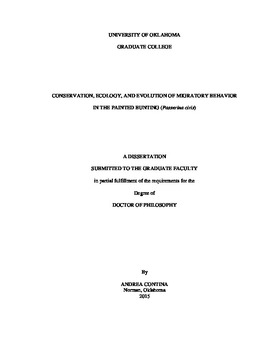| dc.description.abstract | In animal migration studies, determining the migratory connectivity of different species is a crucial step to understand the ecology and evolution of complex behavioral traits as well as to implement effective conservation management plans of declining species. Intrinsic markers, such as stable isotopes and genetic markers, in conjunction with miniaturized light-level geolocator devices, provide high resolution tools to study the ecology and evolution of migration in birds smaller than 20 grams and offer insight on the breeding population of origin of those individuals trapped and sold in the international pet trade market. For example, from 2005 to 2009, CITES documented more than 317,000 live birds sold annually within an industry estimated to be worth billions of US dollars per year. In this context, migratory species can be particularly difficult to protect because any management effort would necessarily involve cooperation among different countries with distinct laws and regulations. A case in point is the Painted Bunting (Passerina ciris), which breeds primarily in the United States and winters in Mexico, Central America, southern Florida, and the Caribbean. I provide a new library of polymorphic microsatellite loci and offer a new tool for genetic population structure studies, forensic analyses, and conservation management of the Painted Bunting and other related species of the genus Passerina. My results suggest that buntings harvested in Central America for the retail market belong to the western breeding population as opposed to the smaller Atlantic breeding population. However, a percentage of both populations come into contact at the wintering grounds in the Yucatan Peninsula where conservation efforts might need to be strengthened.Furthermore, during my investigations on the molting ecology of the Painted Buntings, I found that birds breeding in Oklahoma and molting in Sinaloa, Mexico, show a clear bimodal pattern of stable isotope ratios in their flight feathers, as previously demonstrated in this species, suggesting that some birds may initiate molt immediately upon arrival in northwestern Mexico whereas others may delay molt. I used geologger tags to test whether differences in the timing and route of fall migration movements were related to stable isotope signatures in primary feathers. I observed variation among individuals in migration routes, wherein birds from the same breeding population differed greatly in their use of molting and wintering locations. However, I did not find a relationship between isotope signatures and the timing or route of fall migration.Furthermore, I investigated possible relationships between variation in two candidate genes implicated in the control of migratory behavior (CLOCK and ADCYAP1) and several aspects of fall migration including initiation date, arrival at molt/stopover sites, and duration of the first leg of fall migration. I evaluated the mutation rate of these candidate genes through an Approximate Bayesian Computation (ABC) coalescent approach and studied the effect of natural selection on their allele frequencies across populations. I found that millennial scale summer temperatures and longitude likely affected the current genotypes of CLOCK and ADCYAP1 in three sampling populations. To search for novel genes associated with migratory performance, I implemented 454 next generation sequencing and generated over 48,000 DNA sequences distributed over the Painted Bunting genome. I assembled an extensive library of candidate genes by annotations extracted from the Mouse Genome Informatics database and I focused on the following candidate genes: ADRA1d, ANKRD17, CISH, and MYH7. I tested these genes across avian migratory and non-migratory species, revealing a surprising degree of allelic variation in some genes. MYH7 correlated with speed of migration (km/day) and body mass across 11 species of songbirds in addition to two novel uncharacterized polymorphic genes that strongly correlated with duration of migration in the Painted Buntings. | en_US |
